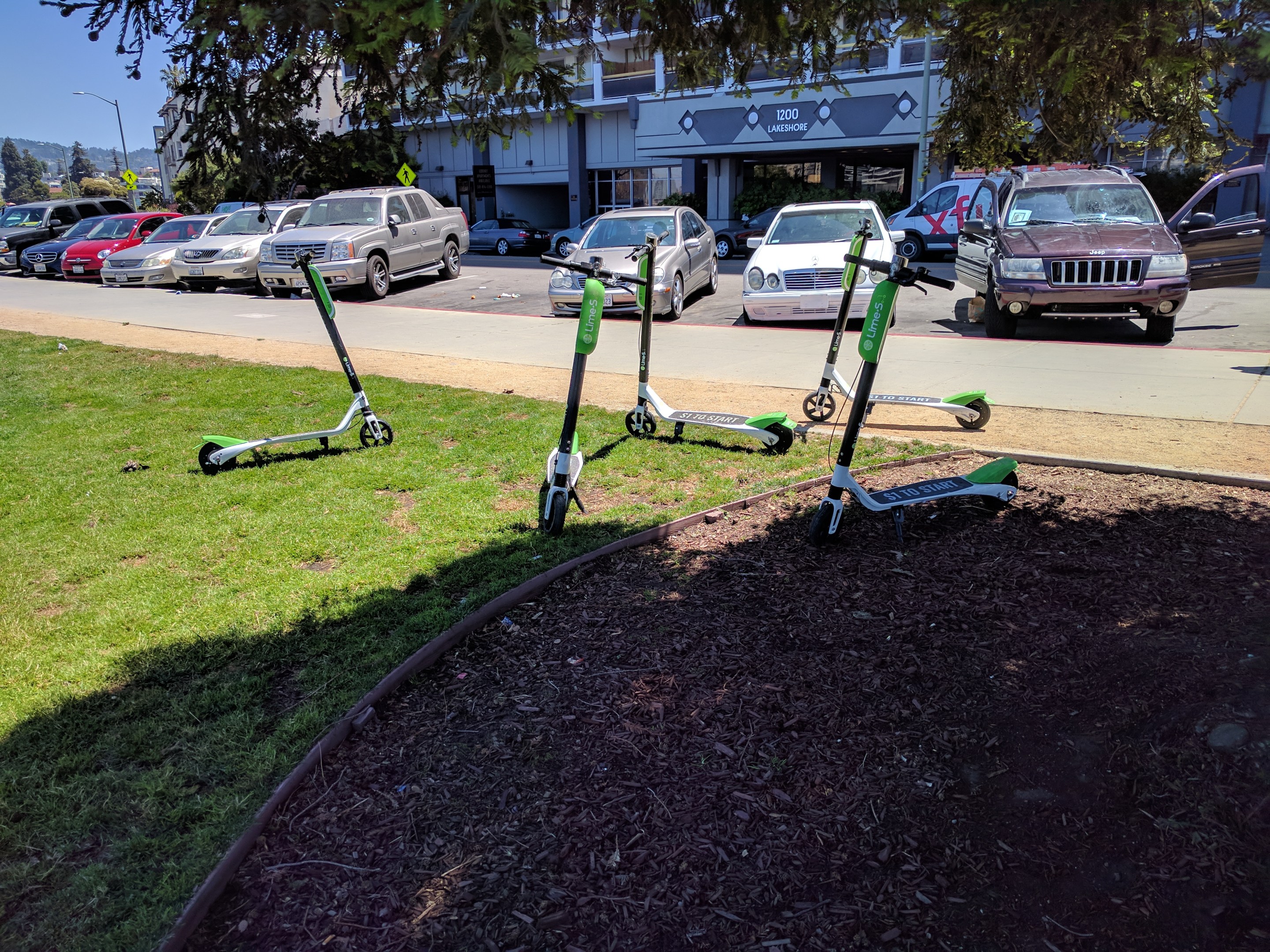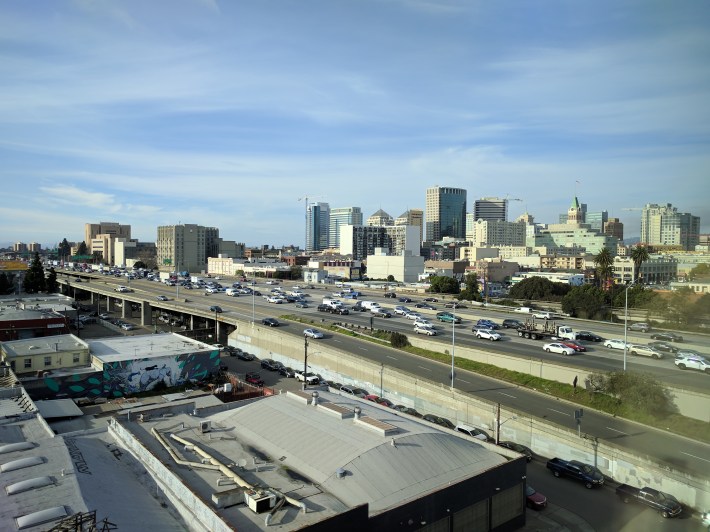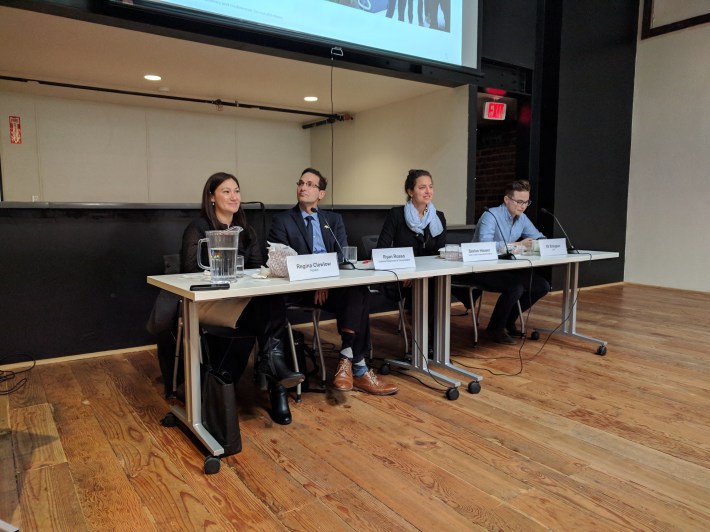SPUR Talk: Scooters Key to Safer Streets?
4:41 PM PST on January 29, 2019

Lime scooters on Lake Merritt in Oakland. Photo: Streetsblog/Rudick
Note: Metropolitan Shuttle, a leader in bus shuttle rentals, regularly sponsors coverage on Streetsblog San Francisco and Streetsblog Los Angeles. Unless noted in the story, Metropolitan Shuttle is not consulted for the content or editorial direction of the sponsored content.
One can park a $50,000 car in the public right of way essentially for free, but, in some cities with scooter permit fees "...the vehicle causing no potholes is paying 20 times what that car pays," explained Ryan Russo, head of Oakland's Department of Transportation. Russo's remarks were part of a SPUR panel discussion today on the future of scooters, regulations, and our streets.
On scooters, "We’ve gotten a lot of complaints, a lot of reactions; it’s the new thing, But there are lots of crazy things we take for granted because they were already here when we got here," he added. "Everybody stores private autos on public streets that anyone can break into and steal--I think that’s a little crazy."
That double standard was a theme that Russo, and the other panelists, share in common: that complaints about scooters are getting a significant amount of press and attention because they are new, while the costs of automobiles is ignored.
"In the 1950s, Oakland turned the city over to cars. You see scars of freeways slashing through our downtown," said Savlan Hauser of the Jack London Business Improvement District, and another of the panelists. "We created terrible spaces for humans."

Before the freeway building age, streets were shared equally by bicycles, pedestrians and, in the case of Jack London Square, trains, produce vendors and forklifts. In a way, there was a sort of disarray that kept cars driving slowly and cautiously instead of zooming down streets at unsafe speeds. Jack London, because of its wholesale produce markets and the train line that remains, still has some of that chaos and charm. "My goal is to maintain chaos in the street, with a belief that it’s the safest street for us all," said Hauser.
All the panelists agreed that scooters might be an important tool in making streets safe again for non-car transport, thanks in large part to their phenomenal growth. "[We've recorded] 720,000 rides in the nine months we’ve serviced Oakland," said E.V. Ellington, manager for Lime for the Bay Area. "That's 125,000 unique riders for a total distance of 745,000 miles."
Ellington argued that those trips are taking cars off the road. A Portland study cited by Ellington showed that 34 percent of scooter riders on any given trip "...would have taken an Uber or Lyft instead," and that "45 percent reported never biking."
That all sounds good, but what about the downsides? There are illegally parked scooters and there's scooter riding on the sidewalk. Plus Uber and Lyft were billed as ways to reduce private vehicle ownership and thereby the space taken up by cars--instead most research now shows they've made traffic even worse. Couldn't scooters cause similar problems perhaps by making sidewalks feel unsafe or drawing too many people from public transportation?
Regina Clewlow of Populus, which helps cities process data on mobility devices, said there are major differences. "Shared mobility services such as ZipCar, Chariot, and others have rolled out rapidly over the last 12 years," she said. "A challenge [for cities] was we had very little data, but scooters have prompted a new conversation about how cities make decisions and what gets to operate in the public right of way."

That's because trip data in the form of heat maps, number of rides, etc., is readily available from scooter companies, so officials can now see how and where they're used. Plus car-based "sharing," such as Uber and Lyft, are regulated by the state. Scooters are regulated by cities, which can then influence how they're deployed. In addition, it's easier for a city to punish a misbehaving scooter company, since they can be scooped up and impounded much more easily. That also punishes the company, rather than the owner of the car as in the case of Uber and Lyft.
"Many cities are receiving real-time data on where all the vehicles are parked, with granular trip choices," on which to base regulations, added Clewlow. "Most city regulations have required operators to pay fees, insurance requirements, and a bond, and some per-vehicle fee."
"Access to data can help us improve active transportation infrastructure," she said, citing an example in Arlington where, based on data from Lime and Bird, the city "...reclaimed one parking spot that can now house 15 bikes and scooters near transit."
Knowing how scooters are being used, and creating shared parking spaces and bike lanes on those routes to accommodate them, is the key. "We want to lower transportation costs for Oaklanders--we want them to have more choices and not be stuck with a homogeneous [car-based] transportation system, with congestion and pollution," said Russo.
He added that Oakland now averages "3,000 scooter trips per day." His city is about to issue regulations, but he said they made a decision not to ban scooters while they developed their permitting framework. "We can’t tell Uber and Lyft to have an equity program or to discount people going to job interviews, but we can tell scooter companies to make sure they deploy in East Oakland and West Oakland."
San Francisco first banned (and still heavily restricts) scooter companies while they figured out a permitting system. Oakland decided on a chiller approach. By working with Lime and Bird, he said they've already gotten some changes to scooter operations. For example, Oakland asked scooter companies to avoid having them stacked up on the newly refurbished Latham Square. They've also reduced "young person riding, two person riding--we've already seen improvements and our regulations aren’t even in effect yet," said Russo.
He is also hopeful by keeping track of where scooters are going, they can build momentum for more protected bike lanes. "We need to clarify where scooters can and can’t be.... and we should re-double our efforts to improve our streets for micro-mobility, the foundation of which is the bicycle," he said.
"We want to put many more bike lanes on the drawing board," concluded Russo. "The data will help us prioritize where to build them first."
For more events like these, visit SPUR’s events page.
Stay in touch
Sign up for our free newsletter



